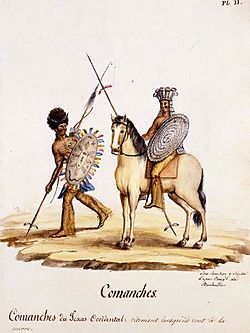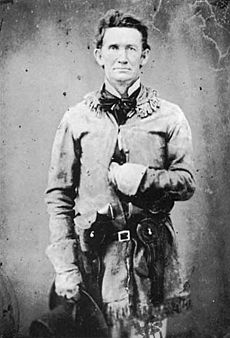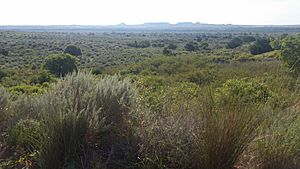Antelope Hills expedition facts for kids
Quick facts for kids Antelope Hills expedition |
|||||||
|---|---|---|---|---|---|---|---|
| Part of the American Indian Wars, Texas-Indian Wars, Apache Wars | |||||||
 Comanches of West Texas in war regalia. Painting by Lino Sánchez y Tapia, circa 1830s |
|||||||
|
|||||||
| Belligerents | |||||||
Tonkawa Anadarko Shawnee |
Comanche Kiowa Apache |
||||||
| Commanders and leaders | |||||||
Placido |
Iron Jacket† Peta Nocona |
||||||
| Strength | |||||||
| ~220 | 200–600 | ||||||
| Casualties and losses | |||||||
| ~50 killed or wounded | 76 killed 16 captured |
||||||
The Antelope Hills expedition was a military campaign that took place from January to May 1858. It involved the Texas Rangers and their Native American allies. They fought against Comanche and Kiowa villages in an area called the Comancheria. This region included parts of western Texas and what is now Oklahoma. The expedition ended with several battles on May 12, 1858. These fights happened near the Antelope Hills and Little Robe Creek, which flows into the Canadian River in Oklahoma. The main battle on May 12, 1858, is often called the Battle of Little Robe Creek.
Contents
Background to the Conflict
Why the Expedition Happened
From 1856 to 1858, there was a lot of fighting on the Texas frontier. Settlers were moving onto lands traditionally used by the Comanche people. This meant less hunting ground and grazing land for the Comanche's horses. Also, the United States government had stopped the Comanche from their usual raids into Mexico. Because of these changes, the Comanche fought back with many attacks on the settlers.
The U.S. Army found it hard to stop the violence. Army units were often moved to different places. Also, federal laws and treaties prevented the Army from attacking Native Americans in the Indian Territories. While some tribes, like the Cherokee, tried to live like settlers, the Comanche and Kiowa continued their traditional way of life in the Comancheria part of the Indian Territories. From there, they would raid into Texas.
As the American Civil War got closer, more federal troops were moved. The 2nd Cavalry left Texas for Utah. This left Texas with fewer soldiers. So, in 1858, Texas Governor Hardin R. Runnels decided to bring back the Texas Rangers. On January 27, 1858, Governor Runnels chose John Salmon "Rip" Ford to lead the Rangers. Ford was a skilled fighter from the Mexican–American War. His job was to take the fight directly to the Comanches in their homeland.
Ford was known as a tough fighter. He often signed casualty reports with "RIP," meaning "Rest in Peace." Governor Runnels gave Ford clear orders: "Follow any trail and all trails of hostile or suspected hostile Indians you may discover and if possible, overtake and chastise them if unfriendly." Ford gathered about 100 Texas Rangers and state militia. He knew he needed more fighters, so he looked for allies who would not need to be paid.

Finding Native American Allies
The Tonkawa Indians were long-time enemies of the Comanche. At this time, they lived on a reservation near the Brazos River in Texas. John Ford decided to ask the Tonkawa for help.
On March 19, 1858, Ford went to the Brazos Reservation, near what is now Fort Worth, Texas. He met with Indian agent Captain L.S. Ross and Chief Placido of the Tonkawa. Ross encouraged Placido to join the fight against their shared enemy. Ford successfully recruited about 120 Native Americans for his campaign. Most of them, 111, were Tonkawa led by Chief Placido. The others were Anadarko and Shawnee warriors. These Native American allies joined with a similar number of Texas Rangers.
Ford's orders from Governor Runnels were very strict. He was to follow any trails of hostile Indians. He was to punish them severely by destroying their homes and food supplies. He was also told not to let anyone stop him. This meant he should ignore any federal laws or treaties that protected the Indian territories in Oklahoma.
The Expedition Begins
Moving from Texas to Oklahoma
Scouts were sent ahead to find Comanche camps north of the Red River. In April 1858, Ford set up Camp Runnels near the old town of Belknap. Ford and Chief Placido planned to follow the Comanche and Kiowa into their strongholds. These areas were among the hills of the Canadian River and in the Wichita Mountains. Their goal was to defeat the warriors, destroy their food, and attack their homes. This would make it harder for the tribes to fight back.
Ford pushed deep into the Comancheria in Texas. He then planned to go even further, even if it meant breaking laws. On April 15, his Rangers and Native American allies crossed the Red River. They entered the Indian Territories in Oklahoma. Ford knew he was breaking federal laws and treaties by entering these lands. But he later said his job was "to find and fight Indians, not to learn geography."
The Battle at Little Robe Creek
At sunrise on May 12, Ford's forces attacked a small Comanche village. It was located in the Canadian River Valley, near the Antelope Hills. Later that day, they attacked a second village. This village fought back much harder until its chief, Iron Jacket, was killed. Iron Jacket's son, Peta Nocona, arrived with more warriors. This led to a third major fight between the Texans and the Comanche. By the end of the day, the Rangers and their allies went back to Texas. The Comanches, though retreating, were gathering more warriors. More of their tribe arrived, along with Kiowa and Kiowa Apache allies.
The Texas forces had few losses. Only four Rangers were hurt, and about a dozen Tonkawa warriors. They reported killing 76 Comanche warriors and taking 16 prisoners. They also captured 300 horses. They burned Iron Jacket's village and the first small village they attacked.
Aftermath of the Expedition
After the expedition, Ford returned to Texas. He asked the governor for more Rangers to continue the fight in the Comancheria. However, Governor Runnels had already spent all the money set aside for defense that year. So, he had to disband the Rangers.
Even though Ford could not continue his campaign, this expedition changed how battles were fought on the Plains. It marked the beginning of the end for the Comanche and Kiowa's power. The American Civil War delayed this outcome, but it was inevitable. For the first time, Texan or American forces had gone deep into the Comancheria. They attacked Comanche villages and returned safely. After the Civil War, the U.S. Army used many of Ford's tactics. These included destroying villages and food supplies, like the buffalo, in their campaigns against the Plains tribes.
See Also
Images for kids
-
Comanches of West Texas in war regalia. Painting by Lino Sánchez y Tapia, circa 1830s
-
Capt. John "Rip" Ford.




